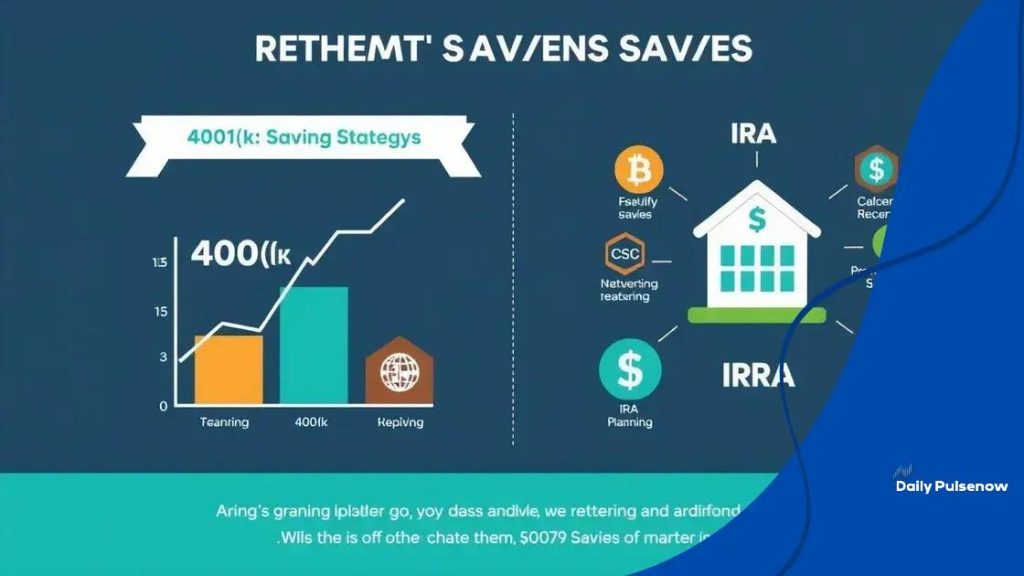401(k) and IRA planning strategies you need to know

Anúncios
Choosing the right retirement account involves assessing your financial goals, understanding different account types like 401(k)s and IRAs, and avoiding common mistakes such as underestimating your retirement needs.
401(k) and IRA planning are crucial for anyone looking to secure their financial future. But do you really know the best ways to maximize your savings? Let’s delve into effective strategies and common mistakes to avoid.
Anúncios
Understanding the basics of 401(k) plans
Understanding the basics of 401(k) plans can empower you to make informed decisions about your retirement savings. A 401(k) plan is a type of employer-sponsored retirement account that allows workers to save a portion of their paycheck before taxes are taken out. This means you can save money now while paying less in taxes. But what exactly do you need to know?
What is a 401(k) Plan?
A 401(k) plan is named after a section of the U.S. Internal Revenue Code. It provides a way for employees to save for retirement while potentially receiving employer matching contributions. This means that if you contribute a certain percentage, your employer may match this up to a specific limit. It’s like getting free money simply for saving.
Contributions and Limits
Employees can contribute a percentage of their salary to their 401(k). The IRS sets annual contribution limits, which can change each year. In 2023, for example, the limit was $22,500 for individuals under 50 years old. If you’re over 50, there’s a catch-up contribution option that allows you to contribute an additional $7,500.
Anúncios
- Tax-deferred growth: Your investments grow without being taxed until withdrawal.
- Employer matches: Many employers offer matching contributions, maximizing your savings.
- Investment choices: A variety of investment options are typically available.
Another important aspect is the withdrawal rules. Withdrawals made before the age of 59½ may incur penalties. However, in certain circumstances, you might be eligible for penalty-free withdrawals, such as financial hardship. Always consult with a financial advisor to make the best decisions for your situation.
Understanding the basics of 401(k) plans lays a solid foundation for retirement planning. When you grasp how contributions work, the benefits of employer matches, and the rules around withdrawals, you can optimize your savings and reach your financial goals more effectively.
Key differences between 401(k) and IRA
When considering retirement savings, it’s essential to know the key differences between 401(k) and IRA accounts. Both serve as tools to help you save for retirement, but they have distinct features and benefits that can affect your savings strategy.
Contribution Limits
A major difference lies in how much you can contribute annually. In 2023, the contribution limit for a 401(k) plan was significantly higher at $22,500 for those under 50, while an IRA allowed up to $6,500. Those over 50 can contribute an extra $7,500 to their 401(k) and an additional $1,000 to their IRA.
Employer Contributions
Another vital distinction is employer involvement. With a 401(k), your employer may offer a matching contribution. This match is basically free money that can greatly enhance your retirement savings. On the other hand, an IRA is an individual account without employer contributions.
- Tax treatment: 401(k) contributions are often made pre-tax, lowering your taxable income.
- IRAs can be traditional (pre-tax) or Roth (after-tax).
- Withdrawal rules vary: 401(k) accounts typically have stricter rules for early withdrawal.
The investment options available also differ between the two. A 401(k) usually comes with a limited selection of investments provided by your employer. Conversely, an IRA gives you a broader range of investment choices, including stocks, bonds, and mutual funds. This flexibility can be beneficial if you want to tailor your portfolio to your risk tolerance and financial goals.
Understanding these key differences between 401(k) and IRA options is crucial when planning for retirement. In essence, your choice may depend on factors like contribution limits, employer contributions, and the investment options that suit your financial strategy.
Effective strategies for maximizing contributions

Maximizing contributions to your retirement accounts is essential for building a secure future. There are several effective strategies for maximizing contributions to 401(k) plans and IRAs that can help you reach your financial goals.
Start Early and Contribute Regularly
The earlier you start, the more time your money has to grow due to compound interest. Aim to contribute a consistent amount from each paycheck. This approach not only builds your retirement savings but also develops a habit of saving.
Take Advantage of Employer Matches
If your employer offers a matching contribution for your 401(k), make sure to contribute enough to get the full match. This is essentially free money that can significantly enhance your retirement savings over time.
- Assess your budget: Determine how much you can comfortably contribute.
- Increase contributions during salary increases: Consider raising your contribution percentage as your salary grows.
- Use windfalls wisely: Apply bonuses or tax refunds directly to your retirement savings.
Consider setting up automatic contributions from your checking account to your retirement savings. This makes it easy to allocate funds without having to think about it each month. You’re less likely to miss the money if it never lands in your checking account to begin with.
Utilizing tax-advantaged accounts like a Health Savings Account (HSA) can also free up money for retirement contributions. Money contributed to HSAs is tax-deductible, and it can be withdrawn tax-free for qualified medical expenses. By saving on healthcare costs, you might be able to redirect those funds into your retirement accounts.
Implementing these effective strategies for maximizing contributions can help you grow your retirement nest egg and achieve financial security more effectively. Planning and consistency are key elements that will serve you well in the long run.
Common pitfalls in retirement savings
When it comes to retirement planning, avoiding common pitfalls is crucial for successful savings. Many people make mistakes that can affect their financial future. Understanding these common pitfalls in retirement savings can help you navigate your path to a secure retirement.
Neglecting to Save Early
One significant mistake is not starting to save early. Time is your best ally when it comes to retirement savings. The earlier you begin, the more you can benefit from compound interest. Waiting too long to make contributions can lead to a smaller nest egg when you retire.
Underestimating Retirement Needs
Many individuals underestimate how much money they will need in retirement. It’s essential to consider healthcare costs, daily living expenses, and potential changes in lifestyle. These factors can significantly impact how much you should aim to save.
- Evaluate your current expenses and project future costs.
- Consider inflation and how it will affect your savings.
- Research healthcare options and costs in retirement.
Another common pitfall is failing to take full advantage of employer matches in a 401(k). If your employer matches contributions, you should aim to contribute enough to receive the full match. This is essentially free money that can significantly help boost your retirement savings.
Additionally, people often have a tendency to cash out their retirement accounts when changing jobs. This practice can lead to lost savings potential and tax penalties. Instead of cashing out, consider rolling over your account into a new employer’s plan or an Individual Retirement Account (IRA).
By understanding these common pitfalls in retirement savings, you can avoid mistakes that might jeopardize your financial security in the future. Knowledge is power when it comes to making the right decisions for your retirement.
How to choose the right retirement account
Choosing the right retirement account is essential for securing your financial future. There are several options available, each with its own benefits and drawbacks. Understanding these choices can help you make an informed decision. Here are some key factors to consider while figuring out how to choose the right retirement account.
Assess Your Financial Goals
Your financial goals should guide your decision. Are you looking for long-term growth, or do you want more flexibility with your withdrawals? Knowing your objective will help you determine which type of account aligns with your needs.
Understand Different Account Types
Some common retirement account types include 401(k) plans, Traditional IRAs, and Roth IRAs. A 401(k) is employer-sponsored and often includes matching contributions. Traditional IRAs allow tax-deductible contributions, while Roth IRAs offer tax-free withdrawals in retirement.
- 401(k): Best for employees looking for employer matches.
- Traditional IRA: Suitable for those who want to lower their taxable income now.
- Roth IRA: Ideal for individuals expecting to be in a higher tax bracket in retirement.
Another factor to consider is your age and how close you are to retirement. If you are younger, you may benefit more from a Roth IRA due to potential for growth. Conversely, if you are nearing retirement, a Traditional IRA might help you lower your current tax burden.
Fees and investment options should also play a role in your decision. Different accounts come with various fees for managing your investments. Ensure you check the expense ratios, any management fees, and how they might affect your overall returns. Look for accounts that provide a variety of investment options to suit your risk tolerance.
By taking into account your financial goals, understanding the different account types, and considering your age and the associated fees, you can better decide how to choose the right retirement account for your needs. Making an informed choice will set you up for success as you save for retirement.
FAQ – Frequently Asked Questions about Retirement Planning
What is a 401(k) plan?
A 401(k) plan is an employer-sponsored retirement account where employees can save for retirement while potentially getting employer matches.
How much should I contribute to my retirement account?
It depends on your financial goals, but a common recommendation is to aim for at least 15% of your salary, including any employer match.
What are the differences between a Traditional IRA and a Roth IRA?
In a Traditional IRA, contributions are made before tax, and withdrawals in retirement are taxed. A Roth IRA uses after-tax contributions, allowing tax-free withdrawals in retirement.
What common mistakes should I avoid when planning for retirement?
Avoid starting to save too late, underestimating your retirement needs, and cashing out your 401(k) when changing jobs.